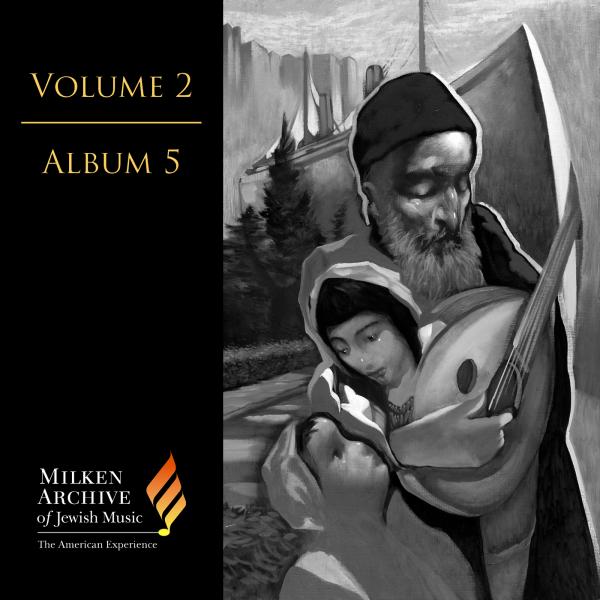Volume 02: Digital Album 5
Title |
Time |
Play |
| Violin Concerto No. 2 | 29:12 | ▼ |
| I profeti: 1. Grave e meditative Isaiah | 12:09 | |
| I profeti: 2. Espressivo e dolente Jeremiah | 09:23 | |
| I profeti: 3. Fiero e impetuoso (ma sostenuto e ben marcato il ritmo) Elijah | 07:20 | |
| Mystical Procession | 07:11 | ▼ |
| Mystical Procession | 07:11 | |
| Kantigas Ulvidadas | 03:04 | ▼ |
| Prelude | 03:04 | |
| Solo kon ti | 04:36 | |
| Yo kon amor | 06:25 | |
| Sivda de mi chikes | 04:55 | |
| Eight Choral Songs for a capella Chorus | 06:37 | ▼ |
| Drinking Song | 01:04 | |
| Nature's Quiet | 00:43 | |
| Love's Desire | 00:55 | |
| Winter is Past | 00:36 | |
| A Vision of Night | 01:05 | |
| The Oak Tree’s Branches | 00:44 | |
| The Lord Suspends The World From Nothing | 01:08 | |
| To Spring | 01:59 | |
| Three Original Sephardi Songs from the Liturgy | 04:41 | ▼ |
| Od yishama | 04:41 | |
| Eishet hayil | 05:35 | |
| Al tira avdi ya'akov | 03:51 |

Castelnuovo-Tedesco - Ben-Amots - Kraft - Bensoussan
For centuries Jews residing on the Iberian Peninsula enjoyed a prolonged period of tolerant Islamic rule that enabled an efflorescence of Jewish culture. Sephardi Jews who were expelled from modern-day Spain and Portugal at the height of the Spanish Inquisition spread from Amsterdam and London to the far reaches of the old Ottoman Empire and beyond, absorbing and influencing the many musical traditions they encountered along the way.
Yet for many years, the rich tradition of Sephardi music remained largely unknown outside of the Sephardi community itself. That began to change in the 20th century when American composers began plumbing the depths of the Sephardi tradition for inspiration, looking not only to Sephardi melodies but also to the rich vein of Sephardi poetry that was created during the Golden Age of Spanish Jewry. Album 5 of the Milken Archive’s Volume 2—A Garden Eastward: Sephardi Inspiration—reveals the fruits of that endeavor with five vastly different musical recordings.
Jascha Heifetz—history’s greatest violinist according to many—makes his Milken Archive debut with Mario Castelnuovo-Tedesco’s second violin concerto, I profeti (The Prophets). Inspired by the biblical prophets Isaiah and Jeremiah, and the biblical figure Elijah, the concerto reflects the composer’s interpretations of the related moods and tones of admonition, teaching, and prediction associated with these prophetic sources. Castelnuovo-Tedesco composed the piece expressly for Jascha Heifetz, who premiered it in 1933 at Carnegie Hall, with Arturo Toscanini and the New York Philharmonic.
Kantigas Ulvidadas, the second cycle of Ladino-based songs by Ofer Ben-Amots (hear a podcast with the composer himself), is a setting of three songs to contemporary Judeo-Spanish texts by Israeli poets Miriam Raymond and Shlomo Avayou. This stunning recording features soprano Jeanne Michèle Charbonnet, known in opera circles for her adeptness at Wagnerian roles, stepping into new territory, aided by pianist Deborah Ayers. In composing the cycle, Ben-Amots prized simplicity and directness over complexity, and uses the piano to emulate the folk style of instruments such as the guitar and oud. Ben-Amots discussed the piece at length with curator Jeff Janeczko in a podcast available on the Archive’s website.
Leo Kraft (1922–2014) made equally important musical contributions as a composer, educator, and author, and left behind a significant corpus of chamber works, songs, orchestral works, and choral compositions. Among the latter is his Eight Choral Songs for a cappella Chorus, which are settings of poems by Moses ibn Ezra, one of the most prolific of all the Spanish-Hebrew poets of the Golden Age of Spanish Jewry. The recording here is by Harold Rosenbaum and the New York Virtuoso Singers, the vocal ensemble that The New York Times critic Anthony Tomasini says has earned the right to include “virtuoso” in its name.
The album takes a sudden, unexpected, and delightful turn with the final three numbers by Cantor Aaron Bensoussan. These three settings of liturgical-biblical texts—Od yishama, Eshet ḥayil, and Al tira advi ya’akov—have been infused with Bensoussan’s Moroccan Sephardi heritage and a healthy dose of Middle Eastern disco. Rich with distinct flavors of North African and other Mediterranean Sephardi sounds, the use of regional instruments such as the bouzouki, darabouka, and oud, alongside modern electronic instruments and synthesized sound, constitute a unique contribution to both the Milken Archive and the world of Jewish music at large.